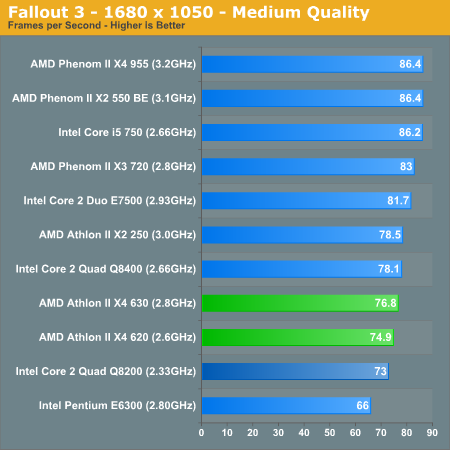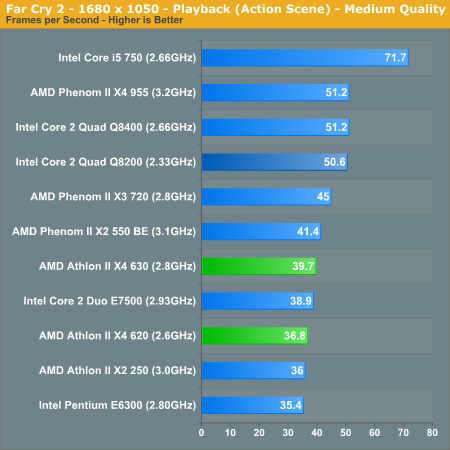AMD Athlon II X4 620 & 630: The First $99 Quad Core CPU
by Anand Lal Shimpi on September 16, 2009 12:00 AM EST- Posted in
- CPUs
Fallout 3 Game Performance
Bethesda’s latest game uses an updated version of the Gamebryo engine (Oblivion). This benchmark takes place immediately outside Vault 101. The character walks away from the vault through the Springvale ruins. The benchmark is measured manually using FRAPS.

Will $99 get you a potent gaming processor? Compared to anything similarly priced, yes, yes it will. If you're building a gaming box you're still better suited for todays games with a faster dual-core processor but if you care about multithreaded performance elsewhere, the X4 won't disappoint.
Left 4 Dead
Zombies? Check. Zombie killing performance:

If this thing only had Lynnfield's turbo modes it would be at the top of these charts. We get respectable performance out of the Athlon II X4s, just nothing earth shattering.
FarCry 2 Multithreaded Game Performance
FarCry 2 ships with the most impressive benchmark tool we’ve ever seen in a PC game. Part of this is due to the fact that Ubisoft actually tapped a number of hardware sites (AnandTech included) from around the world to aid in the planning for the benchmark.
For our purposes we ran the CPU benchmark included in the latest patch:

The FarCry 2 CPU bench seriously favors the Intel CPUs. This is the first and only time where the Athlon II X4 looks like it doesn't make sense. Given its success in the rest of the suite, I'll give it a pass.
Crysis Warhead

Faster than an E6300 (cheaper) but slower than a Q8200 (more expensive), the Athlon II X4 620 does very well given its price.










150 Comments
View All Comments
Chlorus - Wednesday, September 16, 2009 - link
He posted right after me...I'm kinda wondering if we should setup a drinking game or something each time he posts.strikeback03 - Wednesday, September 16, 2009 - link
Good idea, and everyone drinks when you spot a new alias.deputc26 - Wednesday, September 16, 2009 - link
I would absolutely love to see a die size comparison. That will give real information on how this chip can make AMD $$.Lokinhow - Wednesday, September 16, 2009 - link
there is a die size comparsion on the first page..P2 X4 = 258 mm2
A2 X4 = 169 mm2
A2 X2 = 117 mm2
C2Q 8xxx = 164 mm2
deputc26 - Wednesday, September 16, 2009 - link
Apparently I'm a moron. Don't know how I missed that unless it was added after initial publication as I read it right after it came out.Eeqmcsq - Wednesday, September 16, 2009 - link
Anand, how did you know whether or not your Athlon II X4s are harvested Denebs?Also, any idea why the Athon II X4s debut at such a high TDP with no L3? I'd think they'd be lower at 65w or at least 80w.
AMD, $100 quad cores is nice... BUT... where's the 45w quads???
Lokinhow - Wednesday, September 16, 2009 - link
I may be wrong, but..I think the high TDP is because we have both Propus and Deneb-Harvested Cores
The Athlon II based on Deneb probably have this 95W TDP, while the ones based on propus core have lower TDP.
I think they have only a few propus core to sell, so that's why they are selling harvesteds Denebs. When there wil have only Athlons II X4 propous based they'll rate it with a lower TDP.
Makes sense?
Spoelie - Wednesday, September 16, 2009 - link
Yes and noIt's a bit strange that the deneb die (630) consumes less power than the propus die (620) in idle if that theory was valid. During load the difference is just as much as the difference in clock speed would indicate. So if the 630 is indeed a deneb (care to rip the IHS of? ;)) then this means that propus is not by definition less power hungry than deneb.
Anand Lal Shimpi - Wednesday, September 16, 2009 - link
AMD specifically told us that our 620s are Propus samples, but that others may be Denebs. I'm not sure how to tell if you have a harvested Deneb just yet.Give AMD some time, I'm sure we'll see them down below 95W as the process matures for these dice.
Take care,
Anand
TA152H - Wednesday, September 16, 2009 - link
Anand,A couple of things. You mentioned the 'small' L2 cache being a problem on one of your benchmarks, but, it's actually twice as large as the one on the Phenom. I'm not sure if this was meant to be a comparison only with the Penryns, but it's a bit confusing.
Also, going back to the L2 cache, how can these possibly be harvested from Phenoms with a bad L3 cache. That would imply the Phenoms are built with 512K L2 cache, with half of it disabled. I really doubt this is the case. You CAN remove the L3, but how do they then double the L2 cache? This seems strange to me.
Based on the relatively poor overclocking potential of this chip, would you attribute that to the L2 cache? Does the L2 cache run with the same number of wait states as that of the Phenom? If so, that could prove to be the main reason for the lower overclocking potential. Any ideas on this?
Also, don't you think it's worth mentioning AMD's greatly superior IGPs, considering this product could easily find it's way in this platform rather often. The processor by itself does make sense, but, even if it didn't, the superior IGP platform still can make AMD processors somewhat attractive.